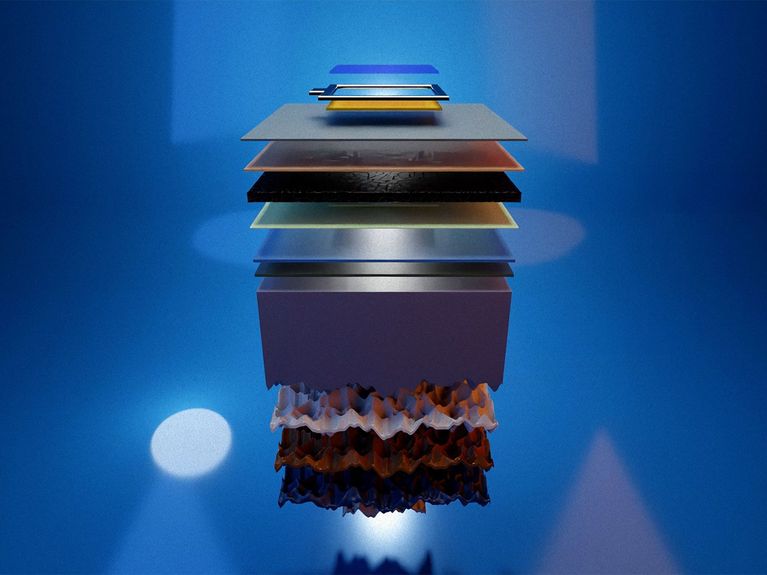Foundation Models
An AI all-rounder for photovoltaics

Structure of a tandem solar cell. Picture: Helmholtz
Inexpensive solar power is a central pillar in the fight against climate change. However, the speed and performance of photovoltaics is still lagging behind. With SOL-AI, Helmholtz researchers want to develop a digital AI assistant that can independently generate new materials and optimize manufacturing processes.
According to the Intergovernmental Panel on Climate Change, global CO2 emissions must fall to net zero by 2050 if global warming is to be limited to 1.5 degrees Celsius. The key to success is the energy transition, and one key technology is photovoltaics. "If we want to meet the Paris climate goals, we need between 80 and 100 terawatts/peak (TWp) of installed photovoltaic capacity by 2050. Today, we are at just over one terawatt," says Stefan Sandfeld, Director of IAS-9 - Institute for Materials Data Science and Informatics at Forschungszentrum Jülich. "That is a huge challenge. At the moment, however, the expansion is still far too slow, and the current generation of solar cells does not meet the required performance targets.
Nevertheless, Stefan Sandfeld is optimistic. After all, new AI applications, so-called foundation models, could also revolutionize materials science and photovoltaics. Together with researchers from the Karlsruhe Institute of Technology (KIT), the Helmholtz Center Berlin for Materials and Energy (HZB) and the Helmholtz Center Hereon, the materials informatics expert is currently working on such a "game changer". "Our SOL-AI project will create an application for photovoltaics that comes very close to the Holy Grail of materials science," explains Stefan Sandfeld. "Engineers have always dreamed of a tool that can say: 'I want a product with exactly these properties'. And the machine then simply dispenses a customized recipe for production."
A navigator in a sea of data
Research and development efforts in the field of photovoltaics have increased rapidly since the 2010s. The result is a veritable flood of information from scientific publications. The problem is that the sheer volume of data is almost impossible to analyze. There is data on the crystal structure of silicon at the atomic level, the layering of materials in a solar cell, optical spectra, so-called jV curves which describe the overall behavior of a solar cell like a fingerprint, and much more. If you want to have a complete overview, from the atom to the entire photovoltaic system, you have to build complex bridges between the extremely different blocks of data.
Stefan Sandfeld, Director at the Institute for Advanced Simulation Materials Data Science and Informatics (IAS-9): Picture: Forschungszentrum Jülich
This is where SOL-AI comes in. "We are combining the expertise of four Helmholtz centers and developing a basic model that brings together and analyzes the huge amounts of very heterogeneous data. The Helmholtz Association is ideally positioned for such an extensive collaboration because it is the only place where the necessary AI knowledge, combined with expertise in the field of photovoltaics, and the computing power to run the model are available," says project manager Stefan Sandfeld. "The AI models used so far process and learn in a controlled manner. This means that humans have to specify exactly what an AI model should output as a learning objective during training. SOL-AI, on the other hand, learns in a self-monitoring fashion without human assistance and can therefore use data for which no learning objective has been specified. It will also be able to interpolate missing data and identify and exclude incorrect data.
Questions to the digital assistant
The training ultimately creates a kind of digital jack-of-all-trades that can be asked semantic questions in normal language. “What is the expected service life of my planned solar cell? Which materials should I use? Where can I optimize my production line? “SOL-AI should provide quick, tailored answers to all of these questions,” explains Stefan Sandfeld. “The AI model will even be able to generate completely new, even more efficient materials and technologies, including manufacturing protocols for predicted jV curves. We are creating a tool that could significantly shorten the development of photovoltaics and the path to highly efficient and cost-effective solar power production.”
SOL-AI is part of the Helmholtz Foundation Model Initiative (HFMI) and, once published, will be freely usable worldwide to accelerate the energy transition as much as possible. Commercial spin-offs will benefit from it to ensure the seamless transfer from basic research to the finished product.
Helmholtz Foundation Model Initiative
Foundation models are a new generation of AI models that have a broad knowledge base and are therefore able to solve a range of complex problems. They are significantly more powerful and flexible than conventional AI models and therefore hold enormous potential for modern, data-driven science. They can become powerful tools that answer a wide range of research questions. The Helmholtz Association is ideally placed to develop such pioneering applications: a wealth of data, powerful supercomputers on which the models can be trained, and in-depth expertise in the field of artificial intelligence. Our goal is to develop foundation models across a broad spectrum of research fields that contribute to solving the big questions of our time.
Readers comments